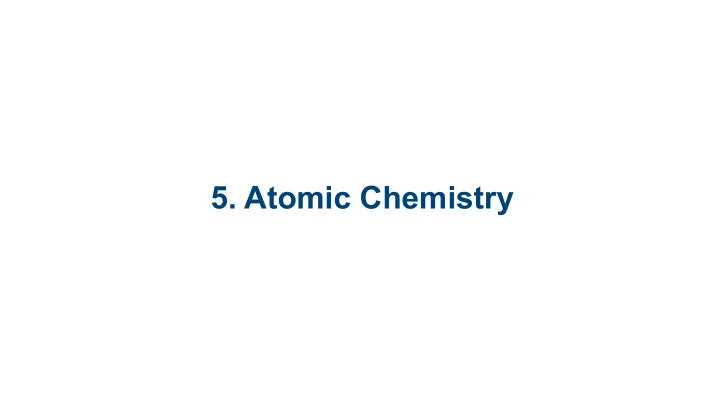

5. Atomic Chemistry
5.1 Structure of the Atom 5.2 The Periodic Table 5.3 Nuclear Reaction 5.4 Rate of Decay and Half-Life
5.1 Structure of the Atom
What is chemistry? Chemistry is the study of matter. Matter makes up everything around us – everything we can see, and some we can’t!
All matter is made up of building blocks called atoms. An element cannot be broken down into any other substance; an atom is the simplest unit of an element that retains the elements characteristics.
A molecule of water is made up of two atoms of hydrogen and one atom of oxygen. H 2 O H H O Hydrogen and Oxygen are both elements; water is a molecule.
Atoms consist of a small, densely packed nucleus composed of positively charged protons and neutrally charged neutrons, surrounded at its periphery by clouds of negatively charged electrons.
outermost “valence” shell, max of 8 e-
5.2 The Periodic Table
Knowing how to navigate the Periodic Table can help us know how a particular element forms a molecule and how tightly it will hold onto the electrons in those bonds.
Elements are arranged on the periodic table by atomic number, or the number of protons in the nucleus. Elements that have the same number of protons , but a different number of neutrons are isotopes of each other. (Like Carbon 13)
The mass of an atom is the sum of the masses of all of the particles that compose that atom protons + neutrons + electrons = atomic mass Protons and neutrons each have a mass of 1 AMU, but electrons are so small, their mass is considered to be negligible, or 0.
What is the atomic mass of carbon?
How many protons and neutrons does Carbon 13 have?
8 is the magic number!
2 e- 6 e- 1 2 3 4 5 6 1 2
5.3 Nuclear Reactions
Atoms are not always stable! Sometimes the nuclei of an atom is unstable, and releases one or more sub- atomic particles in order to become more stable. When this happens, an element is said to be radioactive.
There are three common modes of decay from radioactive nuclei: α (alpha) decay β (beta) decay and γ (gamma) radiation
In alpha decay, an alpha particle (a package of two protons and two neutrons) is released. This usually occurs in elements with a mass number above 60.
210 206 Po Pb 84 82 4 He 2 α particle
Beta decay can be (+) or (-). A beta particle is a high speed electron or positron (same particle with reversed charge).
Beta decay results in an increase or decrease in atomic number, with the mass number remaining the same. Beta decay converts a neutron into a proton while releasing a beta particle.
131 131 I Xe 53 54 0 e -1 β particle
Gamma radiation is high frequency and high energy electromagnetic radiation, usually given off along with alpha or beta decay. Gamma rays are photons, and gamma radiation has no impact on either mass or charge.
5.4 Rate of Decay and Half-Life
Atoms are not always stable! Sometimes the nuclei of an atom is unstable, and releases one or more sub-atomic particles in order to become more stable. When this happens, an element is said to be radioactive.
Half-Life is the amount of time it takes for 50% of an isotope to decay.
Strontium-85 has a half-life of 65.2 days. If you start with 20 grams of strontium-85, how long will it take before you have only 5 grams left?
Strontium-85 has a half-life of 65.2 days. If you start with 20 grams of strontium-85, how long will it take before you have only 5 grams left? 1 half-life leaves you with 20/2 = 10 grams. Another half-life leaves you with 10/2 = 5 grams
Strontium-85 has a half- life of 65.2 days. 2 half-lives = (65.2)(2) = 130.4 days
Recommend
More recommend